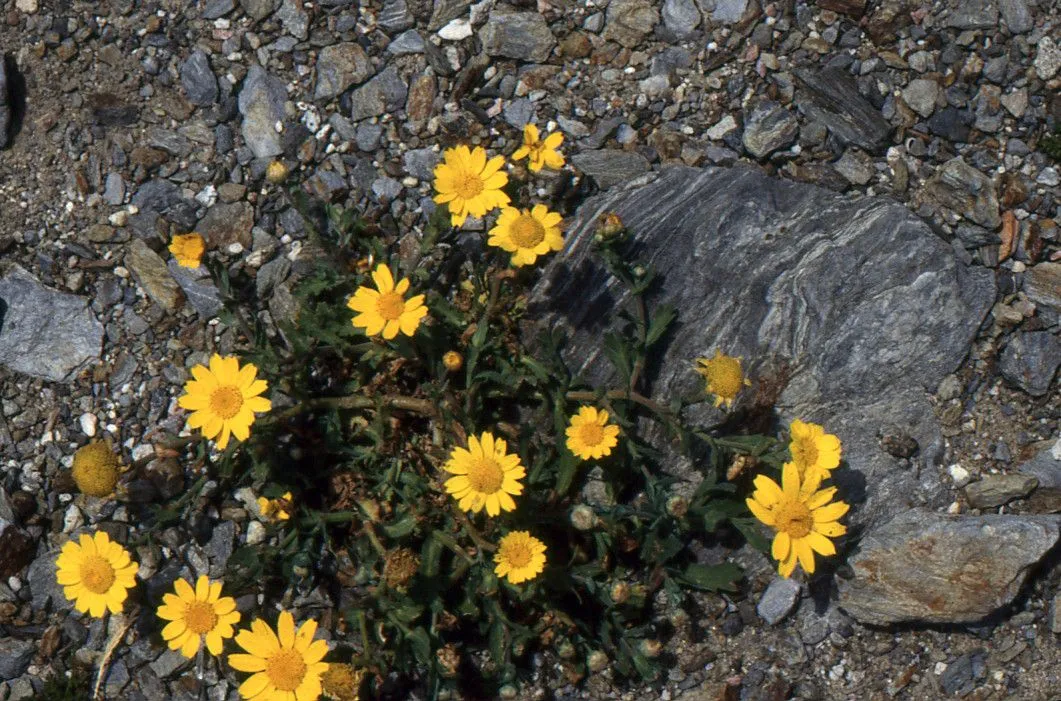
Author: (L.) Fourr.
Bibliography: Ann. Soc. Linn. Lyon, sér. 2, 17: 90 (1869)
Year: 1869
Status: accepted
Rank: species
Genus: Glebionis
Vegetable: False
Observations: Europe to Medit and C. Asia
Corn chrysanthemum, scientifically known as Glebionis segetum, is a plant species that belongs to the Asteraceae family. This charming and resilient flora has roots that traverse regions from Europe to the Mediterranean and Central Asia, showcasing its adaptability to various climates and terrains. Corn chrysanthemum is often recognized for its bright and attractive yellow flowers, which stand out vividly against the greenery of fields and meadows.
Botanically chronicled in 1869 in the Annals of the Linnean Society of Lyon, the Corn chrysanthemum was described by the botanist Fourreau, abbreviated as (L.) Fourr. in scientific referencing. This perennial beauty has captured the attention of botanists and horticulturists alike for its vibrant hue and ecological versatility.
Historically, the Corn chrysanthemum has been a common sight in agricultural landscapes, often seen intermingling with crop fields, which is reflected in its common name. Despite its charm, it can sometimes be considered a weed in commercial agriculture due to its robust and persistent nature. However, its presence is also known to support a variety of pollinators, adding ecological value to its ornamental appeal.
In horticulture, Glebionis segetum is appreciated for its ease of cultivation and its ability to thrive in various soil types, from the fertile loams of the European countryside to the tougher, more arid soils found in Central Asia. Gardeners value this plant not only for its aesthetic contribution but also for its low maintenance and drought-resistant properties.
Overall, Corn chrysanthemum embodies a blend of historical relevance, ecological contribution, and ornamental beauty, making it a worthy subject of interest for both scientific study and garden enthusiasts.
Eng: corn marigold, corndaisy, corn chrysanthemum, corn-marigold, corn daisy, yellow oxeye
Spa: corona de rey
Dan: gul okseøje
Por: margaridinha-folha-de-ervilha, malmequer
Deu: saat-wucherblume, saatwucherblume
Fra: chrysanthème des moissons, marguerite dorée, chrysanthème des blés
Swe: gullkrage
Nor: marigul
Nld: gele ganzenbloem
Sme: gollečehpor, krysantema
Cym: aban, gold, gold mair, gold yr ŷd, golt, graban yr ŷd, melyn yr ŷd, rhuddos, rhuddos y gors, rhuddos yr ŷd
Gla: bile-bhuidhe, bilean-buidhe
En: Corn chrysanthemum, Corn-marigold, Corndaisy, Corn Marigold, Corn daisy, Yellow oxeye
Ca: Ull de bou
Zh: Nan tong hao
Da: Gul okseøje
Nl: Gele ganzenbloem, Gele Ganzebloem
Fr: Chrysanthème des moissons, Marguerite dorée, Chrysanthème des blés, Marguerite jaune
De: Saatwucherblume, Saat-Wucherblume, Echte Saatwucherblume, Saat-Margerite
It: Crisantemo campestre
Se: Gollečehpor, Krysantema
No: Marigul
Pt: Malmequer, Margaridinha-folha-de-ervilha
Gd: Bile-bhuidhe, Bilean-buidhe
Es: Corona de Rey
Sv: Gullkrage
Cy: Aban, Gold, Gold Mair, Gold yr Ŷd, Golt, Graban yr Ŷd, Melyn yr Ŷd, Rhuddos, Rhuddos y Gors, Rhuddos yr Ŷd
Taken Jun 25, 2018 by Denise de Lassat (cc-by-sa)
Taken May 6, 1996 by Tela Botanica − Liliane ROUBAUDI (cc-by-sa)
Taken May 6, 1996 by Tela Botanica − Liliane ROUBAUDI (cc-by-sa)
Taken May 16, 2017 by De Lanriec Annie (cc-by-sa)
Taken May 6, 1996 by Tela Botanica − Liliane ROUBAUDI (cc-by-sa)
Taken Apr 10, 2011 by Tela Botanica − Liliane Roubaudi (cc-by-sa)
Taken Jun 22, 2008 by Tela Botanica − Laurent PETIT (cc-by-sa)
Taken Apr 10, 2011 by Tela Botanica − Liliane Roubaudi (cc-by-sa)
Taken May 7, 2020 by Llandrich anna (cc-by-sa)
Taken Apr 6, 2014 by Lugifa Lugifa (cc-by-sa)
Taken Feb 26, 2007 by EOL − Luigi Rignanese (cc-by-nc)
Taken Apr 25, 2013 by Tela Botanica − Emmanuel STRATMAINS (cc-by-sa)
Taken Apr 25, 2013 by Tela Botanica − Emmanuel STRATMAINS (cc-by-sa)
Taken Jan 23, 2020 by Cheref Madjid (cc-by-sa)
Taken Jun 14, 2022 by Acosta García Isabel (cc-by-sa)
Taken May 7, 2020 by Llandrich anna (cc-by-sa)
Taken Mar 14, 2021 by Escalante Riccardo (cc-by-sa)
Taken May 7, 2020 by Llandrich anna (cc-by-sa)
Taken Jun 14, 2022 by Acosta García Isabel (cc-by-sa)
Taken May 6, 1996 by Tela Botanica − Liliane ROUBAUDI (cc-by-sa)
Taken Jun 11, 2018 by Lise Saint-Arroman (cc-by-sa)
Taken May 8, 2020 by Natalia Candame (cc-by-sa)
Taken Jun 1, 2021 by nicolas (cc-by-sa)
Taken Sep 12, 2020 by Dieter Albrecht (cc-by-sa)
Taken May 14, 2021 by Monteiro Henrique (cc-by-sa)
Taken Sep 3, 2020 by Charly Chauveau (cc-by-sa)
Taken May 14, 2021 by Sande Luis (cc-by-sa)
Taken Jun 18, 2021 by Willen Th Van t Zelfde (cc-by-sa)
Taken Apr 26, 2006 by EOL − Luigi Rignanese (cc-by-nc)
Taken Aug 25, 2021 by Pierre LEON (cc-by-sa)
© copyright of the Board of Trustees of the Royal Botanic Gardens, Kew.
© copyright of the Board of Trustees of the Royal Botanic Gardens, Kew.
© copyright of the Board of Trustees of the Royal Botanic Gardens, Kew.
Growth habit: Forb/herb
Ph maximum: 5.5
Ph minimum: 5.0
Light: 7
Atmospheric humidity: 5
Bloom months: [‘jun’, ‘jul’, ‘aug’]
Soil nutriments: 6
Family: Myrtaceae Author: (F.Muell.) K.D.Hill & L.A.S.Johnson Bibliography: Telopea 6: 402 (1995) Year: 1995 Status:…
Family: Rubiaceae Author: Pierre ex A.Froehner Bibliography: Notizbl. Bot. Gart. Berlin-Dahlem 1: 237 (1897) Year:…
Family: Sapindaceae Author: Koidz. Bibliography: J. Coll. Sci. Imp. Univ. Tokyo 32(1): 38 (1911) Year:…
Family: Asteraceae Author: A.Gray Bibliography: Pacif. Railr. Rep.: 107 (1857) Year: 1857 Status: accepted Rank:…
Family: Fabaceae Author: Medik. Bibliography: Vorles. Churpfälz. Phys.-Ökon. Ges. 2: 398 (1787) Year: 1787 Status:…
Family: Aspleniaceae Author: (Cav.) Alston Bibliography: Bull. Misc. Inform. Kew 1932: 309 (1932) Year: 1932…